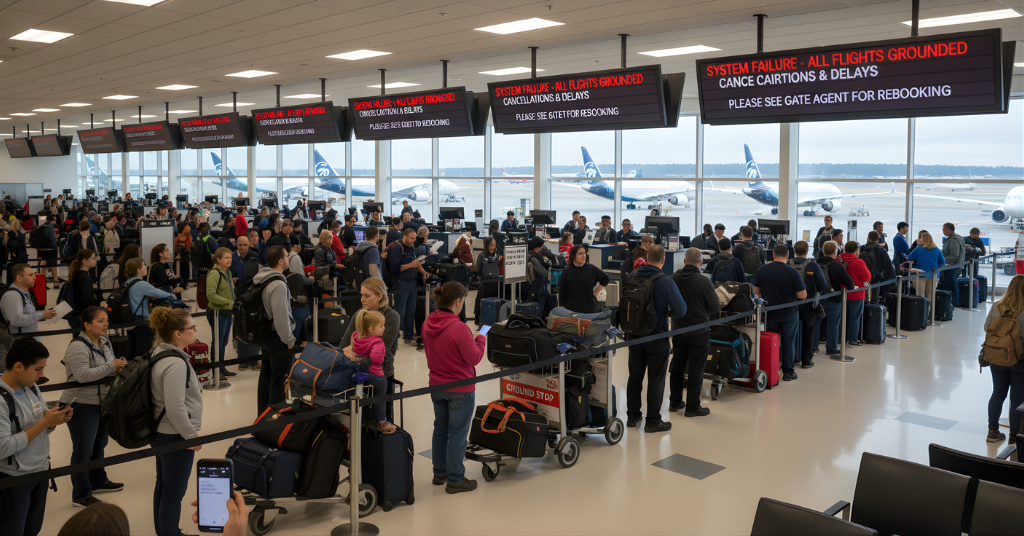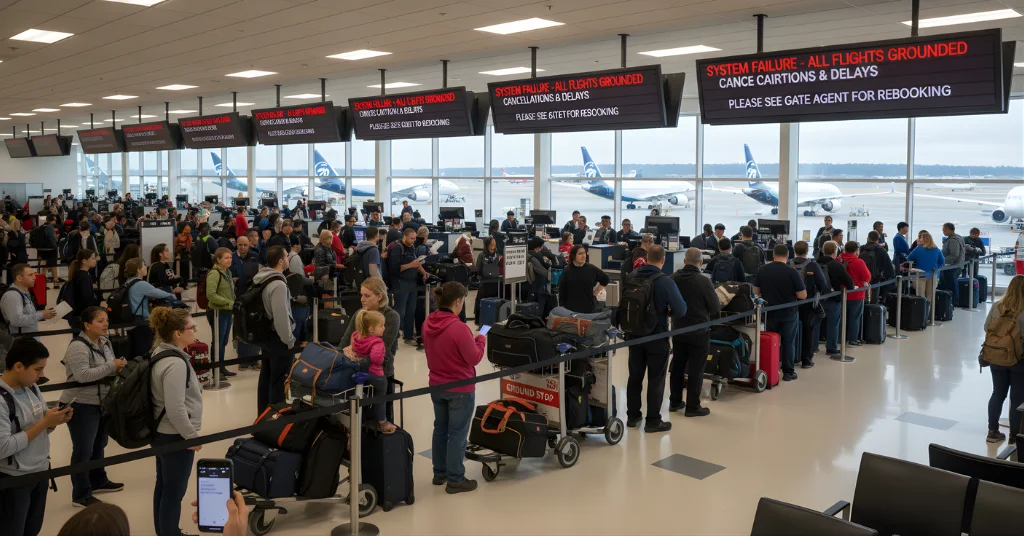
Alaska Airlines IT Failure Causes Widespread Flight Disruption
Travel plans were thrown into chaos for thousands of Alaska Airlines passengers today as a crippling system-wide IT outage forced the carrier to issue a ground stop for all flights, both mainline and those operated by regional subsidiaries. The unprecedented move halted all departures and prevented any aircraft from taking off, causing a domino effect of delays and cancellations across its network.
The incident underscores the critical reliance of modern air travel on digital infrastructure, where a single point of failure can bring an entire airline to a standstill.
What Happened? The Details of the Disruption
The problems began in the early morning hours, with the airline officially acknowledging the issue and implementing the ground stop around afternoon of October 23, 2025.. The core of the problem was a failure in the airline’s internal IT systems.
Total Ground Stop: For a significant period, Alaska Airlines took the rare step of prohibiting all flight departures system-wide.
Cause: The primary cause was reported as an “IT system outage” impacting critical operational functions. While not specified, such failures typically involve systems responsible for:
Flight planning and weight/balance calculations.
Passenger check-in and boarding.
Crew scheduling and communications.
Resumption of Service: After several hours, the airline announced it had begun to restore systems and would gradually resume operations. However, the residual disruption is expected to last throughout the day.
The Ripple Effect: Immediate Consequences for Travelers
The ground stop had an immediate and severe impact on the travel day:
Stranded Passengers: Travelers were left stranded at airports across Alaska’s network, including major hubs like Seattle (SEA) and Portland (PDX).
Cascading Delays and Cancellations: Even after the ground stop was lifted, the backlog of aircraft and displaced crews created a cascade of delays and forced cancellations.
Check-In Chaos: The outage made it impossible for customers to check in for flights online or at airport kiosks, leading to long lines at customer service desks.
Gate Congestion: With flights unable to depart, gates became clogged, further complicating the recovery process for arriving aircraft.
“We Are So Sorry”: The Airline’s Response
Alaska Airlines communicated with customers primarily through its social media channels and official app, as its website was also reportedly affected.
Public Apology: The airline issued a public apology, stating, “We are so sorry for the frustration and inconvenience this is causing our guests.”
Flexible Travel Policy: The airline implemented a flexible travel waiver, allowing passengers whose flights were canceled or significantly delayed to rebook without change fees.
Manual Processes: In some locations, agents resorted to manual processes to assist passengers, though this was a slow and labor-intensive workaround.
Beyond Alaska: A Broader Industry Pattern
While the scale of this event is significant for Alaska Airlines, it is not an isolated incident in the aviation industry. Similar IT meltdowns have plagued other major carriers in recent years, including:
Southwest Airlines: A catastrophic system failure in December 2022 led to over 16,000 flight cancellations.
British Airways: A power surge and IT failure in 2017 caused a complete operational collapse.
These repeated events highlight a systemic vulnerability. Airlines run on a complex patchwork of legacy systems and newer digital platforms. When these systems fail, there is often no quick fix, and manual backups are insufficient for the scale of modern airline operations.
What to Do If Your Flight Is Affected
If you are an Alaska Airlines passenger with upcoming travel, here are the recommended steps:
Check Your Flight Status: Before heading to the airport, use the Alaska Airlines app or website to check your flight’s status. Do not rely on third-party sites.
Review the Travel Waiver: Understand the terms of the flexible travel policy, which typically allows rebooking within a specific date range.
Contact the Airline: If your flight is canceled, you are entitled to a full refund. For rebooking, be prepared for long wait times on the phone; using the app or website may be faster.
Know Your Rights: While the outage is within the airline’s control, the U.S. does not mandate compensation for delays/cancellations like the EU. However, the airline is still responsible for providing refunds for canceled flights.
Conclusion: A Stark Reminder of Digital Fragility
Today’s system failure at Alaska Airlines is more than a simple travel headache; it is a stark reminder of the fragility of the digital systems that underpin our connected world. As airlines continue to modernize, building resilient and redundant IT infrastructure is not just a matter of convenience—it is essential for maintaining the trust of the traveling public and the stability of the national airspace system. The path to recovery for Alaska will be long, and the incident will undoubtedly prompt a serious internal review to prevent a recurrence.

